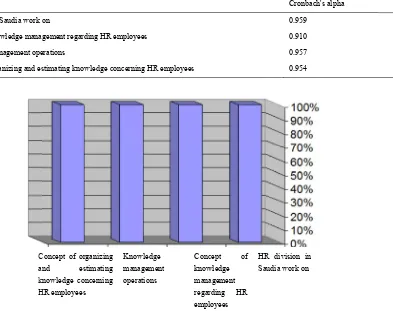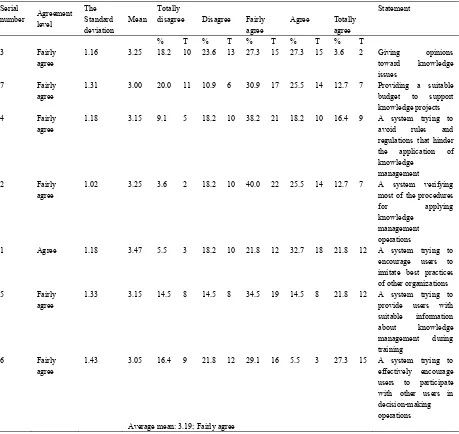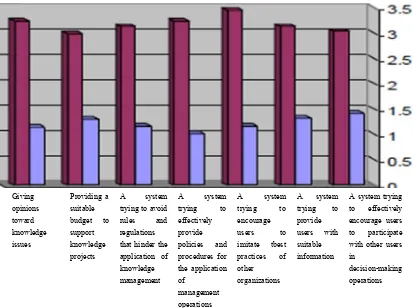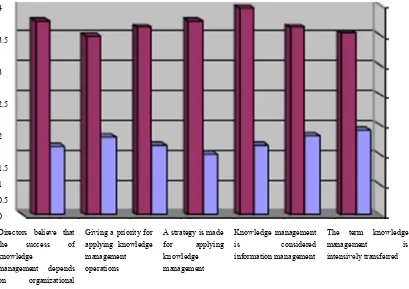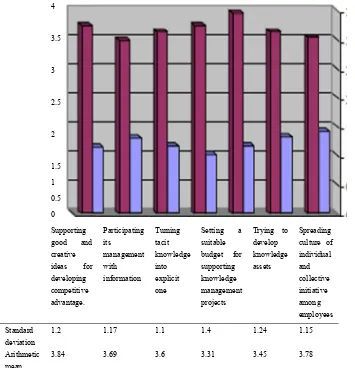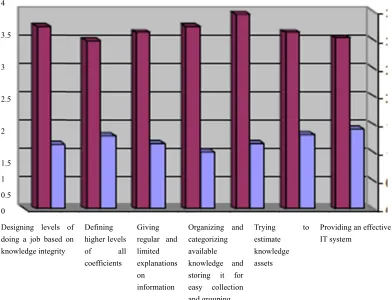International Journal of Business and Management; Vol. 11, No. 3; 2016 ISSN 1833-3850 E-ISSN 1833-8119 Published by Canadian Center of Science and Education
235
Importance of Knowledge Management in Establishing Organization
Strategy: Study on Saudi Arabian Airlines HR Division, Jeddah
Khalil Yaghi1 & Yaser Omar Sindi1 1
Information Science Department, King Abdulaziz University, Jeddah, KSA
Correspondence: Khalil Yaghi, Information Science Department, King Abdulaziz University, Jeddah, KSA. Tel: 966-560-299-639. E-mail: [email protected]
Received: December 9, 2016 Accepted: February 15, 2016 Online Published: February 25, 2016
doi:10.5539/ijbm.v11n3p235 URL: http://dx.doi.org/10.5539/ijbm.v11n3p235
Abstract
This study was aimed at determining the awareness of the Saudi Arabian Airlines (Saudia) human resources (HR) division employees about the role of knowledge management in the company. In addition, their understanding of the concept of knowledge management was also evaluated. Further, the degree to which knowledge management processes were practically employed by the HR employees in the company was also determined. A descriptive and analytical course was employed as a proper method in this study. The study sample was selected from Saudi employees working in Jeddah; owing to their large number, a random sample of 60 employees was chosen. The questionnaire method was employed in this study, and several results were obtained. Some of the main results are as follows. The system encouraged the participants to follow the best practices of other organizations and ensure that managers understand that successful knowledge depends on organizational culture. Further, knowledge management is considered as information management, and study participations agreed to some extent to the knowledge management concept for HR employees. In addition, it was pointed out that good and creative ideas for improving competitive advantage are supported and an individual and group initiative culture is spread between employees.
Keywords: knowledge management, knowledge management processes, organizational strategy, organization culture, human resources
1. Introduction
Information technology (IT) has played a significant role in bringing about economic transformation and social growth, as well as a comprehensive change in almost all aspects of life. It is now regarded as the most important element in production and investment. Moreover, it generates large revenues for many countries and costs high for many others. The cost of IT includes the costs of equipment, tools, software, systems, maintenance, and training. Recently, advanced technology has become very important for us, and one of our primary uses of technology is to manage our knowledge. Knowledge is represented by human experience (Donovan, 2008), values, beliefs, and skills; these are regarded as important elements in an age that derives its name from its identification—the knowledge age. Indeed, knowledge today is an indispensable source used by organizations in production and provision of their services (Bontis, 1999).
According to (Hegazy, 2005, p. 11), “Knowledge management is regarded as one of the most important strategy and modern administrative methods to make change, development and achieve the competitive feature. Its importance has been proved in industry, health and production.”
In addition, (Negm, 2004, p. 709) stated that knowledge is a new origin and the newest production factor recognized as the main source of competitive features in management.
Owing to the various concerns of organizations, economies, and societies employing knowledge management—which involves many challenges, especially in development and competition fields—this study is an attempt to demonstrate the importance of knowledge management in establishing organizational strategy.
www.ccsenet.org/ijbm International Journal of Business and Management Vol. 11, No. 3; 2016
236
moreover, knowledge is increasingly contributing to converting these organizations into part of a new global economy known as the knowledge economy.
1.1 Problems and Questionnaires Used in This Study
The issue of knowledge application by many organizations is analyzed from two perspectives. The first one focuses on technical tools, means, and methods where the financial implications of knowledge management become important; thus, this perspective is concerned with short-term factors. In contrast, the second perspective focuses on methods, approaches, and social and strategic events that demonstrate the human approach to knowledge management (Hislop, 2003). Therefore, this perspective focuses on the long-term vision.
On the basis of these perspectives and considering the significant role played by knowledge management in many organizational aspects (e.g., supporting skills and competition, improving production and performance, assisting decision making, establishing value, and encouraging innovation) (Mehrdad, 2011), the central problem of this study was to determine the role of knowledge management in establishing organizational strategy. To determine the scope of the problem, the following questions were formulated:
1) What is the importance of the stages of establishing, acquiring, organizing, and using information in knowledge management?
2) What is the importance of strategy bases in applying knowledge management?
3) Is there any relation between strategic bases and the knowledge management process?
1.2 Significance of This Study
This study is very significant as it addresses a key issue related to the human resources (HR) division of the Saudi Arabian airlines (Saudia). This issue can be explained as follows. The HR division represents an environment for which development and innovation are main features; therefore, it is essential to focus upon these features. Knowledge management is a means to achieve this. Therefore, understanding the importance of knowledge and managing it correctly is a goal that individuals and societies seek to achieve.
In this regard, (Ghareeb, 2000, p. 10) stated, “All calls for releasing thinking, granting freedom for knowledge, making the opportunity for innovation and creation available in the age when the knowledge importance is one of the important factors of success. So, the knowledge management imposes itself strongly on the arena due to the development of knowledge fields and the escalation of its importance.”
Further, (Al-Sabagh, 2002, p. 16) opined, “The knowledge management is involved in many social events, or in other meaning, it has become an effective power that all societies use to achieve its progress on others or at least become on an equal basis; technically, scientifically and cultural with these societies. The knowledge management provides many opportunities for organizations in the progressive societies in order to achieve the competitive progress through the creation of new techniques, production means and work methods which contribute in reducing costs and increasing profits and all of this can be called “Knowledge Industry” that becomes recently an essential topic in the most progressive societies.”
(Bryson, 2003) stated that participation, communication, and exchange of knowledge among employees play a significant role in establishing organizational strategy. Moreover, these processes contribute to reconciling interests and contradictive values and create a good method that help in decision making and successful execution of processes based on the organization’s vision and message.
From a practical viewpoint, this study is very significant owing to the low number of local researches and studies that address the possibility of the development of Saudia by using knowledge management processes. In addition, this study would be regarded as a small study conducted in the kingdom of Saudi Arabia that addressed the topic of knowledge management. Therefore, this study can be a guideline for the employees of Saudia. In addition, it is expected that the results obtained in this study would assist employees and officials in the kingdom in taking necessary measures to develop and achieve the country's goals.
1.3 Goals
1) Determine the extent of awareness of the HR division employees about the importance of knowledge management in an organization.
2) Determine the extent of awareness of the HR division employees about the concept of knowledge management in an organization.
www.ccsenet.org/ijbm International Journal of Business and Management Vol. 11, No. 3; 2016
237 1.4 Describe Relevant Scholarship
1) Bayad and Smen (2003): “Knowledge management: Reality and prospects”
This study involved an analysis of the concept of the existence of knowledge management borders that were investigated in several studies. The aim of this study was to track the development of this initiative and included various initiatives. Researchers focused on four main attitudes. In addition, they referred to initiatives aimed at setting a knowledge management system in organizations based on two types of strategies: first that is based on HR, which depends upon personal knowledge, and second that is based on information, which depends on codified knowledge. On the basis of this information, both researchers thought that the development path of knowledge management depends on the development and enhancement attitudes of personal and codified knowledge. This knowledge itself depends on the dynamic interactions between implicit and virtual knowledge both in an individual and collective manner. These knowledge types are explained in the Halazon model of knowledge proposed by Nonka and Takeuchi; this model can be regarded as a foundation to establish additional value in an organization.
Therefore, efforts for establishing knowledge management should be mobilized on an organizational level according to the following four main attitudes: encouragement of production, formation and contribution of knowledge through regulative learning via dialogue and discussions, sharing of experiences; and several interactions in the work field. Moreover, knowledge should be acquired by searching within contexts, implementing data and data systems for knowledge, regulating the organization's memory and date, using appropriate tools and methods that ensure the improvement of knowledge management, such as assistive programs for decision making, skill management programs, and administration systems for best practices. Finally, best use should be made of abilities afforded by communication and IT systems in order to exchange knowledge through the establishment of societies within several networks by employing the available technical methods as a collective work program.
2) (Randall, 2008): “Identifying the knowledge processes: Study the adoption of team, behavioral and motive machinery and leadership processes”
This study was conducted at Florida University, Miami. It was aimed at (1) identifying knowledge, behavioral, and motive processes that foster the adoption of a team with unexpected changes and sudden events, and (2) describing team and leadership processes that result in achieving these operations. Results indicated that the knowledge capacity of a team and the work required to achieve these goals by collective participation instead of the team leader's role were related. Moreover, the quality of mental methods and strategies employed by team members (emergent knowledge cases) and the extent of exchanging information among team members (behavioral process) were also related. Teams with high-quality mental models and similar high information levels were found to have a high capacity to behave and adapt with changes in their surroundings. In addition, they showed higher levels of effective decision making.
3) (Ba and Leona 2004): “Knowledge management and institutional culture: Social point of view”
This study was carried out at the George Washington University. It was aimed at investigating the relation between knowledge management and institutional culture. In this study, institutional education systems and competitive values frames were employed. The institutional cultures investigated in the study indicated that there were many strong, meditative, and weak cultures. Further, results indicated that the highest culture had the highest degree of knowledge management and performance.
4) Al-Fares study, Suleiman: “Master about the role of knowledge management in rising efficiency of organization performance” (field study on the conversion industries and organizations in Damascus)
This study was aimed at determining the role of knowledge management in improving the performance level in an organization. The study involved 10 modern companies. An analytical descriptive approach was used to collect data. A typical sample consisted of (42 industrial organizations working in the food, textile, and clothing sectors in Damascus (all were medium and large organizations with employees not less than 25).
The study included general managers, directors of administrations, heads of divisions, and specialists from the 10 organizations.
www.ccsenet.org/ijbm International Journal of Business and Management Vol. 11, No. 3; 2016
238
5) Al-Sharfa study, Salwa: “Master about the role of knowledge management and information technology in achieving competitive benefits in the existing banks in Gaza”
This study was aimed at determining the role of knowledge management and IT in achieving competitive benefits in the existing banks in Gaza.
An analytical descriptive approach was applied in this study, and a questionnaire was distributed to all general managers and heads of divisions in the related banks. The sample consisted of 174 employees.
The following results were found in this study:
-The existing banks in Gaza used a knowledge management system in all units and divisions. They used communication and IT systems, as well as the skills and experiences of human beings and their knowledge about development and renaissance to attain adequate connection with the surroundings. In addition, they used this knowledge to realize development aided by advanced technology and information.
-A separate regulative unit or special division for managing knowledge and IT was not present in any of the banks in Gaza. However, knowledge management and IT systems were operational in the banks.
This study included the following recommendations:
-The awareness and understanding of bank officials about hard challenges, continuous obstacles, and intensive competition they are expected to face in Gaza both presently and in the future should be increased.
-Bank officials in Gaza should pay more attention to knowledge management; moreover, they should work toward establishing a definite administrative framework to manage knowledge and IT.
6) Boaacha study, Mubarak and Bin Mansour Lelia: “A research of knowledge management as a modern administrative attitude in the age of globalization”
This study was aimed at identifying the elements of knowledge management and its importance. An analytical descriptive approach was employed in this study. The following results were obtained:
-Knowledge management is necessary for the stability of organizations and also maintains their competitive strength. Therefore, knowledge management is essential for organizations in order to regulate, use, maintain, and develop the abilities of their employees.
-Knowledge management is a necessary strategy rather than an optional one among other strategies that an organization employs owing to rapid changes in the information field where the existence of knowledge management affords a significant advantage. Without knowledge, no organization can continue and survive.
The following recommendations were made in this study:
-Modern organizations should review their traditional functions in a knowledge frame. In other words, there should be a new job called “knowledge management job.”
-Organizations should provide knowledge on a wider basis. This means that data, information, and knowledge systems should be developed to enable employees to use them. Moreover, systems that facilitate acquiring knowledge and identifying its sources should be developed.
-A supportive technical infrastructure for knowledge management processes should be provided.
-Higher administrators in organizations should pay more attention to knowledge management in order to improve HR efficiency and general performance level.
2. Methodology
A descriptive method was used in this study. This method is one of the most important methods and the most frequently used in researches; therefore, it was the most suitable for this study. This method can be used to describe and explain facts and define real circumstances, as well as to define common and prevailing practices. It is a method that can be used to describe and explain a particular phenomenon. The study sample consisted of HR employees working in Saudia, Jeddah, in the year 1435 AH/2014 AD.
2.1 Study Sampling
The study sample consisted of 55 employees from the HR division in Saudia, Jeddah, in the year 1435 AH/2014 AD. They were the ones who received a questionnaire, 60 of which were distributed. The questionnaire was used as a tool in this study for collecting relevant data and information because of its nature regarding its targets, methodology, and community. This tool was prepared on the basis of on the following factors:
www.ccsen
2) Studies 2.1.1 Stage
The const literature a
First step: organizatio
Concept of
Knowledge
Concept of
net.org/ijbm
used in the fie es of Question
truction of the as follows:
defining the t onal strategies
ep: defining th :
shing the HR d
ncept of knowl edge managem
ncept of knowl
: distributing t ple (60 employ henticity of Da
’s alpha was u of 16 employe .937, as show . Depending on ng the results w
ronbach’s alph
n in Saudia work o
f knowledge mana
e management ope
f organizing and es
C an k H
Intern
eld of knowled nnaire Building
e study tool in
arget of the stu .
he measuremen
division in Sau
ledge managem ment operations
ledge organiza
the questionna yees in the HR ta Collection T
used for estim ees, equal to 20 wn in Table 1.
n the results, th were determin
Concept of organi nd estima knowledge concer HR employees
F
nt aspects of th
udia
ment concernin s
ation in additio
aire in its final R sector in Jedd
Tool
mating the cons 0% of the total This result c he practical im ed.
HR employees
dge concerning HR
Knowledg
Figure 1. Cronb
l of Business and
239 ent.
ral steps to m
measuring the
he study tool b
ng HR employ
on to its evalua
state. The que dah).
sistency coeffi l study sample confirmed the mplications of t
R employees
Conc
bach’s alpha c
d Management
make it field-r
impact of kno
by dividing the
yees
ation regarding
estionnaire in
ficient by appl . Cronbach’s a reliability of the statistical a
HR
eady by revie
owledge mana
e study tool in
g HR employee
its final state i
lying it to a ra alpha was estim f the research
analysis of dat
Cronbach's
ewing the rese
agement in def
nto four dimen
es
is distributed t
andom sample mated by SPSS
tool used for ta and the abili
www.ccsenet.org/ijbm International Journal of Business and Management Vol. 11, No. 3; 2016
240
Moreover, for defining the attitudes of individuals while answering the questions of the main study, every answer was provided a weight and an extent as shown in the following table:
Table 2. Statistical
Categories Weight Value of weighted mean
Totally disagree 1 1–1.80
Disagree 2 1.80–2.60
Fairly agree 3 2.60–3.40
Agree 4 3.40–4.20
Totally agree 5 4.20–5
For defining the categories to which an individual belonged, the level of acceptance and prevailing opinion for every statement was defined according to the value of the weighted mean of sample answers as follows:
Table 3. Different percentages, repetitions, arithmetic means, and standard deviations of the axis (work of HR division in Saudia)
Serial
number Agreement
level
The Standard deviation
Mean
Totally
disagree Disagree Fairly agree
Agree Totally agree
Statement
% T % T % T % T % T
3 Fairly agree
1.16 3.25 18.2 10 23.6 13 27.3 15 27.3 15 3.6 2 Giving opinions
toward knowledge issues
7 Fairly agree
1.31 3.00 20.0 11 10.9 6 30.9 17 25.5 14 12.7 7 Providing a suitable
budget to support knowledge projects 4 Fairly
agree
1.18 3.15 9.1 5 18.2 10 38.2 21 18.2 10 16.4 9 A system trying to
avoid rules and regulations that hinder the application of knowledge
management 2 Fairly
agree
1.02 3.25 3.6 2 18.2 10 40.0 22 25.5 14 12.7 7 A system verifying
most of the procedures
for applying knowledge
management operations
1 Agree 1.18 3.47 5.5 3 18.2 10 21.8 12 32.7 18 21.8 12 A system trying to
encourage users to imitate best practices of other organizations 5 Fairly
agree
1.33 3.15 14.5 8 14.5 8 34.5 19 14.5 8 21.8 12 A system trying to
provide users with suitable information about knowledge management during training
6 Fairly agree
1.43 3.05 16.4 9 21.8 12 29.1 16 5.5 3 27.3 15 A system trying to
effectively encourage users to participate with other users in decision-making operations Average mean: 3.19; Fairly agree
www.ccsen a suitable opinion wa A strategy is applying k management Giving a pr
net.org/ijbm
On the basis o ts fairly agree
ments were reg statement “A ds to the highe budget to sup as “fairly agre
Pr
Figure 2. Arith
Different perc ransferred
4 riority for
Intern
of the average with the statem
gressively arran system trying est mean (3.47) pport knowled roviding a uitable
udget to upport
nowledge ojects
hmetic means
centages, repet
e arithmetic m ments of this a
nged on the ba g to encourag
) and the preva dge projects” c
A
hinder the lication of wledge nagement
and standard d
titions, arithm
l of Business and
241 mean that rea axis.
asis of the arit ge users to im
ailing opinion corresponds to cedures for
application
nagement erations
deviations for a
metic means, a
T
ached 3.19, it
thmetic mean f mitate best pr was “agree.” F o the smallest
A mitate tbest
actices of her
ganizations
axis (work of H
and standard
Mean
t was conclud
for every state ractices of ot Further, the sta
mean (3.00)
HR division in
deviations for
and the preva
system trying effectively courage users
participate th other users
cision-making erations
n Saudia)
r axis (concep
www.ccsen
applying k management it was conc
The statem “Directors this order manageme elieve that
ess of
depends anizational
Ave
shows the per e management cluded that the
ments were reg s believe that t with a mean ent is consider opinion of “di
tors believe that success of ledge
gement depends organizational e
Percentages, r
Intern
30 17 20.0
erage mean: 3.02;
rcentages, rep t concept conce e study particip
gressively arra the success of n of 3.45 and
Giving a prio applying kno
Fairly agree
etitions, arithm erning the HR pants fairly agr
anged on the b f knowledge m d a prevailing on managemen
l of Business and
242
5 7.3 4
metic means, R division. On t
ree with the st
asis of the arit management d g opinion of
s, and standard erning HR emp
d Management
3.45 9.1
and standard the basis of the tatements of th
thmetic means depends on org “agree.” Furt e end of the o
nowledge manage consi formation manage
d deviations fo ployees)
1.17
d deviations o e average mea his axis.
s. It was found ganizational cu ther, the state order with a m
or axis (knowle
Vol. 11, No. 3;
agree
1 Agree
of the axis o an that reached
d that the state ulture” was fir ement “Knowl mean of 2.57 a
erm knowledge ment is ely transferred
www.ccsenet.org/ijbm International Journal of Business and Management Vol. 11, No. 3; 2016
243
Table 5. Different percentages, repetitions, arithmetic means, and standard deviations for axis (knowledge management operations)
Serial number Agreement
level The
Standard deviation Mean
Totally disagree Disagree
Fairly agree Agree
Totally agree Statement
% T % T % T % T % T
1 Agree 1.20
3.84 3.6 2 12.7 7 20.0 11 23.6 13 40.0 22 Supporting good and creative ideas for developing
competitive advantage
3 Agree 1.17
3.69 3,6 2 12.7 7 27.3 15 23.6 13 40.0 18 Participating its management with information
4 Agree 1.10
3.60 3.6 2 14.5 8 21.8 12 38.2 21 21.8 12 Turning tacit knowledge into explicit one
6 Fairly agree 1.40
3.31 9.1 5 30.9 17 7.3 4 25.5 14 27.3 15 Setting a suitable budget for supporting knowledge
management projects
5 Agree 1.24
3.45 3.6 2 25.5 14 20.0 11 23.6 13 27.3 15 Trying to develop knowledge assets
2 Agree 1.15
3.78 3.6 2 12.7 7 18.2 10 32.7 18 32.7 18 Spreading culture of individual and collective initiative among employees
Average mean: 3.61; Agree
Table 5 shows the percentages, repetitions, arithmetic means, and standard deviations for the axis of knowledge management operations. On the basis of the average mean that reached 3.61, it was concluded that the study participants agree with the statements of this axis.
www.ccsen knowledge a it for easy of all coeffici Designing doing a job knowledge in
4. Different pe
Different perc g and estimatin
Tot agr
T
17 n effective
9 and storing
collection g
15 gular and anations on
12 gher levels
ients ng knowledge r
Agree
erage mean: 3.81;
national Journal regarding HR
Fairly
l of Business and
244
metic means, a ment operation
metic means, a employees)
and standard d ns)
and standard
Mean
deviations for a
deviations for
r axis (concep
www.ccsen
HR division Knowledge regarding HR Knowledge operations
Concept o
estimating k HR employee
Table 7 sh
net.org/ijbm
ows percentag g and estimatin
sis of the aver s of the axis.
ments were re ng and categor t mean (4.02) e assets” corre
5
5
5
5
esigning levels ing a job based o owledge integrity
Arithmetic m
Relation betwee
in Saudia work on management con R employees
managem
of organizing knowledge regar es
hows the relati
Intern
ges, repetitions ng knowledge r
rage mean that
gressively arra rizing availabl ) with a prev
sponded to the
Defining
eans and stand
en study axes
ions between t
national Journal
s, arithmetic m regarding HR
t reached 3.81
anged on the e knowledge a vailing opinio e lowest mean
Giving regular and limited
the study axes
l of Business and
245 means, and stan
employees.
, it was conclu
basis of arith and storing it f n of “agree.” (3.65) with a p
Organizing a categorizing available knowledge a storing it f easy collecti and grouping
ns for axis (con g HR employe
edge ement
t regarding ployees
hmetic means. for easy collec ” Further, the prevailing opin
ncept of organ ees)
Knowledge management operations
0.797**
1
s of correlatio
ns for the axis,
study participa
It was found tion and group statement “T nion of “agree
Providin IT system to
izing and estim
Concept
ants agree wit
that the state ping” correspo Trying to esti e.”
ng an effective m
mating knowle
of organizing knowledge reg ees
www.ccsenet.org/ijbm International Journal of Business and Management Vol. 11, No. 3; 2016
246
relation among the different study axes at a statistical level (0.01).
3. Results
The system tries to encourage the users to imitate the best practices of other organizations.
The system relates most of the special policies and procedures of knowledge management.
The study participants fairly agree upon the axis of the work for the HR division in Saudia.
The managers believe that the success of knowledge is based on organizational culture.
Knowledge management is considered information management.
The study participants fairly agree upon the axis of the knowledge management concept regarding HR employees.
Good and innovative ideas are advocated for developing a competitive advantage.
A culture of individual and group initiatives should be developed among employees.
The study participants agree upon the axis of knowledge management operations.
Available data and information are organized and categorized and then stored for easy collection and grouping.
Limited and regular explanations on information are made.
The study participants agree upon the concept of organizing and estimating knowledge regarding HR employees.
A relation exists between the different study axes at a statistical level (0.01).
4. Conclusion and Recommendations
Considerable attention should be paid upon knowledge management by the Saudia management because it is the only factor that can propel it toward the future. Through knowledge management, Saudia can make great leaps in technical, information, strategic, and economic aspects to compete with other organizations.
A system should be developed for imitating other organizations that have applied the knowledge management concept in the past. This can be used for organizing training programs for the staff, so that everyone benefits from such training. Outdoor training is important for making employees more experienced and efficient.
An organizational culture in knowledge management should be developed for employees via lectures, symposiums, conferences, and workshops. Employees should be committed to do researches on knowledge management, which will enable them to practice the knowledge management culture.
Awareness should be crated about the experiences of organizations specialized in the knowledge management field by utilizing all available means to learn and teach via the Internet. These experiences should be shared and practiced not only by Saudia but by all other Saudi and world organizations.
The concept of spreading knowledge between different Saudia administrations should be strengthened, thereby giving them strategic importance for future plans. In addition, this concept should be imparted to the targets of Saudia in order to realize the latest scientific and cognitive developments.
References
Al-Gharib, F. S. (2000). The knowledge management. The series of information bridge. Diwan of civil service: Kuwait.
Al-Khalidi, I. B. (2011). The administration dictionary. Amman: Dar Osama for publishing and distribution.
Al-Otaibi, Y. A. (1427). The knowledge management and applying it in the Saudi Universities: Applied study on Umm Al-Qura University. A not published master thesis: Umm Al-Qura University.
Al-Qubaisi, S. (2011). The knowledge management. Cairo: the Arab administrative development organization.
Al-Sabbagh, E. (2002). The knowledge management and its role in building the information community.
Bontis, N. (1999). Managing organizational knowledge by diagnosing intellectual capital: Framing and advancing the state of the field. International Journal of Technology Management,18(5-8), 433-462.
Bryson, J. (2003). The strategic planning of public and nonprofit organizations. Lebanon: Lebanon Bookshop.
Donovan, A. M. (2008). Effectively Managing The 21st Century Knowledge Worker. Journal of Knowledge Management Practice, 9(1), 14-16.
www.ccsenet.org/ijbm International Journal of Business and Management Vol. 11, No. 3; 2016
247
Hislop, D. (2003). Linking human resource management and knowledge management via commitment: A review and research agenda. Employee Relations, 25(2),182-202.
Mehrdad G. (2011). Knowledge Management and Transformational Leadership in Organizational Success. International Journal of Information and Education Technology, 1(5), 377-379.
Negm, N. A. (1425). Book review: post knowledge management (pp. 709-724). Riyadh.
The Guide of the Saudi Airlines for Systems and Administrative Procedures (2014). Human resources sector.
Copyrights
Copyright for this article is retained by the author(s), with first publication rights granted to the journal.
